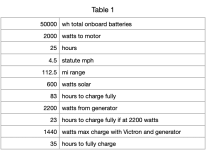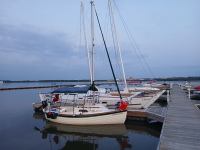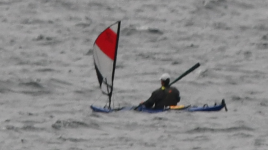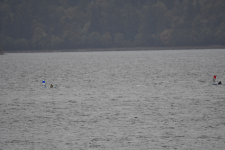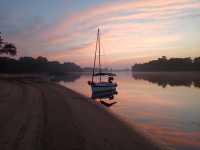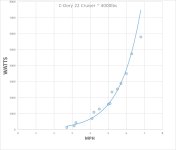The idea of cruising the great PNW fully-electric is compelling. Many, if not most, people that do it are limited to hull speed or less (trawlers and sailboats), though typically with longer boats and thus somewhat higher hull speed. Trawlers can only motor. Practically, sailboats almost always motor, and rarely actually sail except in a local area. A C-Dory hull is designed for planing, and thus likely not as efficient as your Montgomery. You will often encounter tides, currents and winds that keep most boats waiting for changes in conditions, sometimes for days, on a summer inside-passage trip.
Tom has significant experience with a fully-electric C-Dory, but seems to be charging his batteries primarily with 110 VAC. Therein lies the "rub". IMHO, the beauty of the PNW region, like the Chesapeake, is the availability of places where you can gunkhole at anchor. I sometimes have wonderful recollection dreams of anchorages, a recent one up a fjord in BC where we watched 8 grizzles play together on the shore as sockeye salmon jumped all around us. We were the only ones there. I can't recall such dreams about mooring at docks.
I've cruised in protected waters (lakes, rivers, south Puget Sound and the Everglades) with several iterations of gear, finally arriving at a 19.5 ft long Wenonah kevlar canoe, a Torqeedo 1103 (overkill), two Torqeedo batteries, and 175 watts of solar as my ideal. Of course, I can also paddle this rig. This setup works well for long trips in protected water, except where the sun is uncooperative. However, canoes have legendary efficiency, motorboats do not. I was able to run my lightly-loaded CD22 at 4.5 statute mph using about 1550 watts of power, 450 from my Minn Kota bow mount (the max it would sustain), and 1100 from the Torqeedo. Tom was able to get about 4.0 with his rig at 1500 watts. This seems workable, though moving at 5 mph would be ideal.
This is the math problem I see with your proposal. First, you have to fit 600 watts of solar. I currently have 350. I have CIGS on my campers, since I often park in partial shade. The CIGS panels I do have seem to have more surface area per watt, and less "shapes" are available to fit the C-Dory 22. I'm really excited about seeing you fit all of these panels, and I'll follow your lead after you do.
So, 600 watts. At 100% efficiency, something I have rarely achieved, you'd need 83 hours to charge your proposed system depleted to fully, which is not a good idea. Even at 1200 watts, you'd need over 40 hours. One advantage of PNW summers is that days are long, but a recent August (the best weather here) trip from Prince Rupert to south Puget Sound saw many days that were overcast, several raining on us. Good fishing though.
So, how to regenerate those watt-hours? You could carry a Honda 2200 generator. If I could manage to get all 2200 watts as available in batteries (impossible according to the laws of Thermodynamics), it would take 23 hours from depleted to charged. Charging with my Victron is limited to about 1440 watts, which at 100% efficiency would be 35 hours. If 110 VAC is available, I guess one could divide into multiple battery banks, and use multiple chargers. Perhaps also more than one generator, or move to a larger system, but if you don't plan to charge with AC, it looks to me that you will need to limit your electric motoring to a few hours per day and pray for sun.
My plan is to put one 5000 watt-hour battery under the galley (done), and one where the water tank used to be (tank removed, battery under consideration). I'll necessarily limit electric motoring to a few hours per day in the most interesting places. I'll often limit motoring to hull speed, as it more than doubles my mpg from 4-4.5 on step to 9-10 mpg. Carrying 100 gallons of fuel, I can motor nearly 1000 miles at hull speed.
It is hard to discount the advantages of the huge energy density of fossil fuels, which is quite available along the inland passage.
Right now, I'm trying to decide whether I want to move to a 48 VDC system from my current 24 VDC.
